Forest
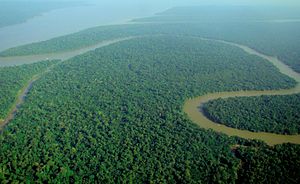
A forest is an
Forests are the largest terrestrial
Forests account for 75% of the
Forests form distinctly different biomes at different latitudes and elevations, and with different precipitation and evapotranspiration rates.[9] These biomes include boreal forests in subarctic climates, tropical moist forests and tropical dry forests around the Equator, and temperate forests at the middle latitudes. Forests form in areas of the Earth with high rainfall, while drier conditions produce a transition to savanna. However, in areas with intermediate rainfall levels, forest transitions to savanna rapidly when the percentage of land that is covered by trees drops below 40 to 45 percent.[10] Research conducted in the Amazon rainforest shows that trees can alter rainfall rates across a region, releasing water from their leaves in anticipation of seasonal rains to trigger the wet season early. Because of this, seasonal rainfall in the Amazon begins two to three months earlier than the climate would otherwise allow.[11][12] Deforestation in the Amazon and anthropogenic climate change hold the potential to interfere with this process, causing the forest to pass a threshold where it transitions into savanna.[13]
Human society and forests can affect one another positively or negatively.
Definitions

Although the word forest is commonly used, there is no universally recognised precise definition, with more than 800 definitions of forest used around the world.[4] Although a forest is usually defined by the presence of trees, under many definitions an area completely lacking trees may still be considered a forest if it grew trees in the past, will grow trees in the future,[19] or was legally designated as a forest regardless of vegetation type.[20][21]
There are three broad categories of definitions of forest in use: administrative, land use, and land cover.[20] Administrative definitions are legal designations, and may not reflect the type of vegetation that grows upon the land; an area can be legally designated "forest" even if no trees grow on it.[20] Land-use definitions are based on the primary purpose the land is used for. Under a land-use definition, any area used primarily for harvesting timber, including areas that have been cleared by harvesting, disease, fire, or for the construction of roads and infrastructure, are still defined as forests, even if they contain no trees. Land-cover definitions define forests based upon the density of trees, area of tree canopy cover, or area of the land occupied by the cross-section of tree trunks (basal area) meeting a particular threshold.[20] This type of definition depends upon the presence of trees sufficient to meet the threshold, or at least of immature trees that are expected to meet the threshold once they mature.[20]
Under land-cover definitions, there is considerable variation on where the cutoff points are between a forest, woodland, and savanna. Under some definitions, to be considered a forest requires very high levels of tree canopy cover, from 60% to 100%,[22] which excludes woodlands and savannas, which have a lower canopy cover. Other definitions consider savannas to be a type of forest, and include all areas with tree canopies over 10%.[19]
Some areas covered with trees are legally defined as agricultural areas, for example
Etymology
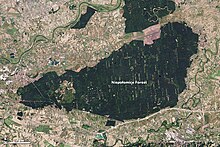
The word

The precise origin of Medieval Latin foresta is obscure. Some authorities claim the word derives from the
Uses of forest in English to denote any uninhabited and unenclosed area are presently considered archaic.
These hunting forests did not necessarily contain any trees. Because that often included significant areas of woodland, "forest" eventually came to connote woodland in general, regardless of tree density.[
Evolutionary history
The first known forests on Earth arose in the
Ecology
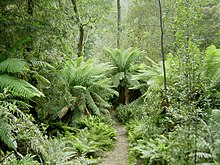
Forests account for 75% of the
Forest ecosystems broadly differ based on
Trees rising up to 35 meters (115 ft) in height add a vertical dimension to the area of land that can support plant and animal species, opening up numerous ecological niches for arboreal animal species, epiphytes, and various species that thrive under the regulated microclimate created under the canopy.[33] Forests have intricate three-dimensional structures that increase in complexity with lower levels of disturbance and greater variety of tree species.[34]
The biodiversity of forests varies considerably according to factors such as forest type, geography, climate, and soils – in addition to human use.[35] Most forest habitats in temperate regions support relatively few animal and plant species, and species that tend to have large geographical distributions, while the montane forests of Africa, South America, Southeast Asia, and lowland forests of Australia, coastal Brazil, the Caribbean islands, Central America, and insular Southeast Asia have many species with small geographical distributions.[35] Areas with dense human populations and intense agricultural land use, such as Europe, parts of Bangladesh, China, India, and North America, are less intact in terms of their biodiversity.[35] Northern Africa, southern Australia, coastal Brazil, Madagascar, and South Africa are also identified as areas with striking losses in biodiversity intactness.[35]
Components
A forest consists of many components that can be broadly divided into two categories: biotic (living) and abiotic (non-living). The living parts include
Layers
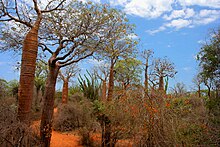
The main layers of all forest types are the forest floor, the understory, and the canopy. The emergent layer, above the canopy, exists in tropical rainforests. Each layer has a different set of plants and animals, depending upon the availability of sunlight, moisture, and food.
- The Forest floor is covered in dead plant material such as fallen leaves and decomposing logs, which .
- Understory is made up of bushes, shrubs, and young trees that are adapted to living in the shade of the canopy.
- Canopy is formed by the mass of intertwined branches, twigs, and leaves of mature trees. The crowns of the dominant trees receive most of the sunlight. This is the most productive part of the trees, where maximum food is produced. The canopy forms a shady, protective "umbrella" over the rest of the forest.
- Emergent layer exists in a tropical rain forest and is composed of a few scattered trees that tower over the canopy.[38]
In botany and countries like Germany and Poland, a different classification of forest vegetation is often used: tree, shrub, herb, and moss layers (see stratification (vegetation)).
Types

Forests are classified differently and to different degrees of specificity. One such classification is in terms of the biomes in which they exist, combined with leaf longevity of the dominant species (whether they are evergreen or deciduous). Another distinction is whether the forests are composed predominantly of broadleaf trees, coniferous (needle-leaved) trees, or mixed.
- Boreal forests occupy the subarcticzone and are generally evergreen and coniferous.
- temperate coniferous forests and temperate rainforests). Warm temperate zones support broadleaf evergreen forests, including laurel forests.
- Tropical and subtropical forests include tropical and subtropical moist forests, tropical and subtropical dry forests, and tropical and subtropical coniferous forests.
- Forests are classified according to physiognomy based on their overall physical structure or old growth vs. second growth).
- Forests can also be classified more specifically based on the climate and the dominant tree species present, resulting in numerous different forest types (e.g., Ponderosa pine/Douglas firforest).
The number of trees in the world, according to a 2015 estimate, is 3 trillion, of which 1.4 trillion are in the tropics or sub-tropics, 0.6 trillion in the temperate zones, and 0.7 trillion in the coniferous boreal forests. The 2015 estimate is about eight times higher than previous estimates, and is based on tree densities measured on over 400,000 plots. It remains subject to a wide margin of error, not least because the samples are mainly from Europe and North America.[40]
Forests can also be classified according to the amount of human alteration.
Different global forest classification systems have been proposed, but none has gained universal acceptance.[42] UNEP-WCMC's forest category classification system is a simplification of other, more complex systems (e.g. UNESCO's forest and woodland 'subformations'). This system divides the world's forests into 26 major types, which reflect climatic zones as well as the principal types of trees. These 26 major types can be reclassified into 6 broader categories: temperate needleleaf, temperate broadleaf and mixed, tropical moist, tropical dry, sparse trees and parkland, and forest plantations.[42] Each category is described in a separate section below.
Temperate needleleaf
Temperate needleleaf forests mostly occupy the higher latitudes of the
Temperate broadleaf and mixed

Tropical moist
There are many different types of
Tropical dry
Sparse trees and savanna
Sparse trees and
Plantations
Forest plantations are generally intended for the production of timber and pulpwood. Commonly mono-specific, planted with even spacing between the trees, and intensively managed, these forests are generally important as habitat for native biodiversity. Some are managed in ways that enhance their biodiversity protection functions and can provide ecosystem services such as nutrient capital maintenance, watershed and soil structure protection and carbon storage.[41][42]
Area

The annual net loss of forest area has decreased since 1990, but the world is not on track to meet the target of the United Nations Strategic Plan for Forests to increase forest area by 3 percent by 2030.[35]

While deforestation is taking place in some areas, new forests are being established through natural expansion or deliberate efforts in other areas. As a result, the net loss of forest area is less than the rate of deforestation; and it, too, is decreasing: from 7.8 million hectares (19 million acres) per year in the 1990s to 4.7 million hectares (12 million acres) per year during 2010–2020.[35] In absolute terms, the global forest area decreased by 178 million hectares (440 million acres; 1,780,000 square kilometres; 690,000 square miles) between 1990 and 2020, which is an area about the size of Libya.[35]
Societal significance
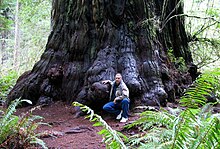

Ecosystem services
Forests provide a diversity of
- Converting carbon dioxide into oxygen and biomass. A full-grown tree produces about 100 kilograms (220 lb) of net oxygen per year.[44]
- Acting as a carbon sink. Therefore, they are necessary to mitigate climate change.[45]
- Aiding in regulating climate. For example, research from 2017 shows that forests induce rainfall. If the forest is cut, it can lead to drought,[46] and in the tropics to occupational heat stress of outdoor workers.[47]
- Purifying water.
- Mitigating natural hazards such as floods.
- Serving as a genetic reserve.
- Serving as a source of lumber and as recreational areas.
- Serving as a source of woodlands and trees for millions of people dependent almost entirely on forests for subsistence for their essential fuelwood, food, and fodder needs.[48]
The main ecosystem services can be summarized in the next table:[49]
| Type of forest | Carbon stored | Biodiversity | Other |
|---|---|---|---|
| Primary Boreal Forests |
1,042 billion tonnes of carbon, more than currently found in the atmosphere, 2 times more than all human caused emissions since the year 1870. | Biodiversity services given by Canada forest alone are estimated as 703 billion dollars per year. Important for almost half of the birds in North America. | Contain 60% of world surface freshwater. |
| Primary Temperate Forests | 119 billion tonnes (like all CO2 emitted by humans in 2005–2017) | Old growth forest has very high biodiversity. Some species link terrestrial ecosystems to marine. | Some trees can live 1,000 years providing many services to humans. Help to protect people from floods and droughts. |
| Primary Tropical Forests | 471 billion tonnes (more than all CO2 emissions from fossil fuel industry from the year 1750) | Contain about two thirds of all species of terrestrial animals and plants. | Creates clouds, rainfall .
|
Some researchers state that forests do not only provide benefits, but can in certain cases also incur costs to humans.[50][51] Forests may impose an economic burden,[52][53] diminish the enjoyment of natural areas,[54] reduce the food-producing capacity of grazing land[55] and cultivated land,[56] reduce biodiversity,[57][58] reduce available water for humans and wildlife,[59][60] harbour dangerous or destructive wildlife,[50][61] and act as reservoirs of human and livestock disease.[62][63]
An important consideration regarding carbon sequestration is that forests can turn from a carbon sink to a carbon source if plant diversity, density or forest area decreases, as has been observed in different tropical forests[64][65][66] The typical tropical forest may become a carbon source by the 2060s.[67] An assessment of European forests found early signs of carbon sink saturation, after decades of increasing strength.[68] The Intergovernmental Panel on Climate Change (IPCC) concluded that a combination of measures aimed at increasing forest carbon stocks, andsustainable timber offtake will generate the largest carbon sequestration benefit.[69]
Forest-dependent people
The term forest-dependent people is used to describe any of a wide variety of livelihoods that are dependent on access to forests, products harvested from forests, or ecosystem services provided by forests, including those of Indigenous peoples dependent on forests.
Indigenous peoples
Forests are fundamental to the culture and livelihood of indigenous people groups that live in and depend on forests,[73] many of which have been removed from and denied access to the lands on which they lived as part of global colonialism. Indigenous lands contain 36% or more of intact forest worldwide, host more biodiversity, and experience less deforestation.[74][75][76] Indigenous activists have argued that degradation of forests and indigenous peoples' marginalization and land dispossession are interconnected.[77][78] Other concerns among indigenous peoples include lack of Indigenous involvement in forest management and loss of knowledge related for the forest ecosystem.[79] Since 2002, the amount of land that is legally owned by or designated for indigenous peoples has broadly increased, but land acquisition in lower-income countries by multinational corporations, often with little or no consultation of indigenous peoples, has also increased.[80] Research in the Amazon rainforest suggests that indigenous methods of agroforestry form reservoirs of biodiversity.[81] In the U.S. state of Wisconsin, forests managed by indigenous people have more plant diversity, fewer invasive species, higher tree regeneration rates, and higher volume of trees.[82]
Management

The management of forests is often referred to as forestry. Forest management has changed considerably over the last few centuries, with rapid changes from the 1980s onward, culminating in a practice now referred to as sustainable forest management. Forest ecologists concentrate on forest patterns and processes, usually with the aim of elucidating cause-and-effect relationships. Foresters who practice sustainable forest management focus on the integration of ecological, social, and economic values, often in consultation with local communities and other stakeholders.
Humans have generally decreased the amount of forest worldwide. Anthropogenic factors that can affect forests include logging,
According to
The forest transition
The transition of a region from forest loss to net gain in forested land is referred to as the forest transition. This change occurs through a few main pathways, including increase in commercial tree plantations, adoption of agroforestry techniques by small farmers, or spontaneous regeneration when former agricultural land is abandoned. It can be motivated by the economic benefits of forests, the ecosystem services forests provide, or cultural changes where people increasingly appreciate forests for their spiritual, aesthetic, or otherwise intrinsic value.[84] According to the Special Report on Global Warming of 1.5 °C of the Intergovernmental Panel on Climate Change, to avoid temperature rise by more than 1.5 degrees above pre-industrial levels, there will need to be an increase in global forest cover equal to the land area of Canada (10 million square kilometres (3.9 million square miles)) by 2050.[45]
China instituted a ban on logging, beginning in 1998, due to the erosion and flooding that it caused.[85] In addition, ambitious tree-planting programmes in countries such as China, India, the United States, and Vietnam – combined with natural expansion of forests in some regions – have added more than 7 million hectares (17 million acres) of new forests annually. As a result, the net loss of forest area was reduced to 5.2 million hectares (13 million acres) per year between 2000 and 2010, down from 8.3 million hectares (21 million acres) annually in the 1990s. In 2015, a study for Nature Climate Change showed that the trend has recently been reversed, leading to an "overall gain" in global biomass and forests. This gain is due especially to reforestation in China and Russia.[86] New forests are not equivalent to old growth forests in terms of species diversity, resilience, and carbon capture. On 7 September 2015, the FAO released a new study stating that over the last 25 years the global deforestation rate has decreased by 50% due to improved management of forests and greater government protection.[87][88]

There is an estimated 726 million hectares (1.79 billion acres) of forest in protected areas worldwide. Of the six major world regions, South America has the highest share of forests in protected areas, at 31 percent. The area of such areas globally has increased by 191 million hectares (470 million acres) since 1990, but the rate of annual increase slowed in 2010–2020.[32]
Smaller areas of
Canada
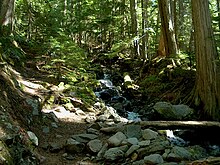
Canada has about 4 million square kilometres (1.5 million square miles) of forest land. More than 90% of forest land is publicly owned and about 50% of the total forest area is allocated for harvesting. These allocated areas are managed using the principles of sustainable forest management, which include extensive consultation with local stakeholders. About eight percent of Canada's forest is legally protected from resource development.
By December 2006, over 1.2 million square kilometres (460,000 square miles) of forest land in Canada (about half the global total) had been certified as being sustainably managed.[91] Clearcutting, first used in the latter half of the 20th century, is less expensive, but devastating to the environment; and companies are required by law to ensure that harvested areas are adequately regenerated. Most Canadian provinces have regulations limiting the size of new clear-cuts, although some older ones grew to 110 square kilometres (42 sq mi) over several years.
The Canadian Forest Service is the government department which looks after Forests in Canada.
Latvia

Latvia has about 3.27 million hectares (8.1 million acres; 12,600 square miles) of forest land, which equates to about 50.5% of Latvia's total area of 64,590 square kilometres (24,938 sq mi) 1.51 million hectares (3.7 million acres) of forest land (46% of total forest land) is publicly owned and 1.75 million hectares (4.3 million acres) of forest land (54% of the total) is in private hands. Latvia's forests have been steadily increasing over the years, which is in contrast to many other nations, mostly due to the forestation of land not used for agriculture. In 1935, there were only 1.757 million hectares (4.34 million acres) of forest; today this has increased by more than 150%. Birch is the most common tree at 28.2%, followed by pine (26.9%), spruce (18.3%), grey alder (9.7%), aspen (8.0%), black alder (5.7%), oak/ash (1.2%), with other hardwood trees making up the rest (2.0%).[92][93]
United States
In the United States, most forests have historically been affected by humans to some degree, though in recent years improved forestry practices have helped regulate or moderate large-scale impacts. The United States Forest Service estimated a net loss of about 2 million hectares (4.9 million acres) between 1997 and 2020; this estimate includes conversion of forest land to other uses, including urban and suburban development, as well as afforestation and natural reversion of abandoned crop and pasture land to forest. In many areas of the United States, the area of forest is stable or increasing, particularly in many northern states. The opposite problem from flooding has plagued national forests, with loggers complaining that a lack of thinning and proper forest management has resulted in large forest fires.[94][95]
See also
- Agroforestry
- Ancient woodland, an official classification of ancient forest in the United Kingdom.
- Bioproducts
- Chase (land)
- Chemnitz petrified forest
- Close to nature forestry
- Cloud forest
- Dendrology
- Dendrometry
- Ecological succession
- Forest dynamics
- Forest migration
- Forest pathology
- Forest restoration
- Great Green Wall (Africa)
- History of the forest in Central Europe
- Hyrcanian forests
- Illegal logging
- Intact forest landscape
- Kelp forest (A forest made mostly if not entirely of Kelp; an underwater forest)
- List of countries by forest area
- List of old-growth forests
- List of superlative trees
- List of tree genera
- List of trees and shrubs by taxonomic family
- Natural environment
- Natural landscape
- Orchard
- Permaforestry
- Primeval forest, a term often used interchangeably with old growth forest
- Rainforest
- REDD-plus
- Savanna
- Silviculture
- Stand level modelling
- Stratification (vegetation)
- Subalpineforest
- Taiga, a biome characterized by coniferous forests
- Temperate broadleaf and mixed forests
- Temperate coniferous forest
- Tree allometry
- Tree farm
- Tree plantations(forestry)
- Tree
- Trees of the world
- Tropical and subtropical coniferous forests
- Tropical and subtropical moist broadleaf forests
- Tropical rainforest
- Urban forest
- Urban reforestation
- Wildcrafting
- Wilderness
- Woodland management
- Woodland
Sources
![]() This article incorporates text from a free content work. Licensed under CC BY-SA 3.0 (license statement/permission). Text taken from Global Forest Resources Assessment 2020 Key findings, FAO, FAO.
This article incorporates text from a free content work. Licensed under CC BY-SA 3.0 (license statement/permission). Text taken from Global Forest Resources Assessment 2020 Key findings, FAO, FAO.
![]() This article incorporates text from a free content work. Licensed under CC BY-SA 3.0 (license statement/permission). Text taken from The State of the World's Forests 2020. In brief – Forests, biodiversity and people, FAO & UNEP, FAO & UNEP.
This article incorporates text from a free content work. Licensed under CC BY-SA 3.0 (license statement/permission). Text taken from The State of the World's Forests 2020. In brief – Forests, biodiversity and people, FAO & UNEP, FAO & UNEP.
References
- ^ "Forest". Dictionary.com. Archived from the original on 19 October 2014. Retrieved 16 November 2014.
- ^ Schuck, Andreas; Päivinen, Risto; Hytönend, Tuomo; Pajari, Brita (2002). "Compilation of Forestry Terms and Definitions" (PDF). Joensuu, Finland: European Forest Institute. Archived (PDF) from the original on 5 June 2015. Retrieved 16 November 2014.
- ^ "Definitions: Indicative definitions taken from the Report of the ad hoc technical expert group on forest biological diversity". Convention on Biological Diversity. 30 November 2006. Archived from the original on 19 December 2014. Retrieved 16 November 2014.
- ^ a b "Forest definition and extent" (PDF). United Nations Environment Programme. 27 January 2010. Archived from the original (PDF) on 26 July 2010. Retrieved 16 November 2014.
- ^ Global Forest Resources Assessment 2020 – Terms and definitions (PDF). Rome: Food and Agriculture Organization. 2018. Archived (PDF) from the original on 9 August 2019.
- S2CID 241416114.
- ^ (PDF) from the original on 7 August 2016.
- ^ S2CID 241416114.
- ^ Holdridge, L.R. Life zone ecology (PDF). San Jose, Costa Rica: Tropical Science Center. Archived (PDF) from the original on 5 October 2016.
- ^ Edwards, Lin. "Forest and savanna can switch quickly". Phys.org.
- ^ Rasmussen, Carol. "New study shows the Amazon makes its own rainy season". nasa.gov.
- ^ Loomis, Ilima. "Trees in the Amazon make their own rain".
- ^ Kimbrough, Liz (16 September 2022). "More droughts are coming, and the Amazon can't keep up: Study". Mongabay.
- ^ Derouin, Sarah (6 January 2022). "Deforestation: facts, causes & effects". Live Science.
- ^ "Deforestation". National Geographic.
- ^ "Eastern Deciduous Forest (U.S. National Park Service)". nps.gov.
- ISBN 978-1-84593-098-1.
- ^ "Deforestation and Its Effect on the Planet". National Geographic Environment. 7 February 2019. Archived from the original on 19 February 2021. Retrieved 21 July 2021.
- ^ a b MacDicken, Kenneth (15 March 2013). "Forest Resources Assessment Working Paper 180" (PDF). Rome: Food and Agriculture Organization of the United Nations Forestry Department. Archived (PDF) from the original on 24 September 2015. Retrieved 16 November 2014.
- ^ a b c d e Watson, Robert T.; Verardo, David J.; Noble, Ian R.; Bolin, Bert; Ravindranath, N.H.; Dokken, David J., eds. (2000). "Land Use, Land-Use Change and Forestry". Intergovernmental Panel on Climate Change. Archived from the original on 29 November 2014. Retrieved 16 November 2014.
- ^ Menzies, Nicholas; Grinspoon, Elisabeth (22 October 2007). "Facts on Forests and Forestry". ForestFacts.org, a subsidiary of GreenFacts.org. Archived from the original on 8 May 2015. Retrieved 16 November 2014.
- ^ "Introduction: Definition of a Forest". MuseumLink Illinois. Archived from the original on 29 October 2014. Retrieved 16 November 2014.
- ^ "A Polish Royal Forest". NASA Earth Observatory. 29 November 2013. Archived from the original on 4 January 2014.
- ^ "Broadsheet: The News Letter for Broadland Tree Wardens" (PDF). April 2011. Archived from the original (PDF) on 29 November 2014. Retrieved 16 November 2014.
- ISBN 978-94-007-1149-5.
- ^ a b c "forest, noun". Oxford English Dictionary online edition. Oxford University Press. Archived from the original on 11 January 2008. Retrieved 22 May 2009.
- ISBN 978-0-395-44895-3.
- ^ "What is a Forest?". Australian Government/Department of Agriculture, Fisheries, and Forestry/Rural Areas. 28 March 2007. Archived from the original on 9 October 2009. Retrieved 25 November 2010.
- ^ Confer John Evelyn, FRS, Sylva, or A Discourse of Forest-Trees and the Propagation of Timber in His Majesty's Dominions (1664); and the title of and use passim in Edward Step, FLS, Wayside and Woodland Trees: A Pocket Guide to the British Sylva (Frederick Warne and Company Limited, London and New York, [many editions]).
- doi:10.1144/jgs2023-204. Archived (PDF) from the original on 9 March 2024.)
{{cite journal}}: CS1 maint: multiple names: authors list (link - ^ a b c d "The First Forests". Devonian Times. Archived from the original on 10 May 2016. Retrieved 9 March 2024.
- ^ S2CID 130116768.
- ^ Cannon, Charles; Schlesinger, William H. (2 August 2021). "Arboreal Dimensions of Biodiversity".
- ^ "Forests of the world in 3-D: Research team analyses complexity of forest structure". phys.org. University of Gottingen.
- ^ S2CID 241416114.
- ^ Davies, Dave (4 May 2021). "Trees Talk To Each Other. 'Mother Tree' Ecologist Hears Lessons For People, Too". Fresh Air. NPR.
- ^ Franklin, Brooke. "This Fall, Leave the Leaves!". usda.gov.
- ^ The Living World. D.A.V. College Managing Committee.
- S2CID 130116768.
- ^ Amos, Jonathan (3 September 2015). "Earth's trees number 'three trillion'". BBC. Archived from the original on 3 September 2015. Retrieved 3 September 2015.
- ^ (PDF) from the original on 21 October 2016.
- ^ ISBN 978-0-520-23668-4.
- ISBN 978-0-520-24660-7.
- ^ Luis Villazon. "How many trees does it take to produce oxygen for one person?". Science Focus. Retrieved 12 August 2019.
- ^ a b Global Warming of 1.5 °C – an IPCC special report on the impacts of global warming of 1.5 °C above pre-industrial levels and related global greenhouse gas emission pathways, in the context of strengthening the global response to the threat of climate change, sustainable development, and efforts to eradicate poverty Summary for Policymakers (PDF). Intergovernmental Panel on Climate Change. 6 October 2018. p. 22. Archived from the original (PDF) on 18 October 2018. Retrieved 11 October 2021.
- PMID 28729375.
- ^ Quaglia, Sofia (17 December 2021). "Deforestation making outdoor work unsafe for millions, says study". The Guardian. Retrieved 16 February 2022.
- S2CID 241858489.
- ^ "Primary Forests: Boreal, Temperate, Tropical". Woodwell Climate Research Center Logo GraphicWoodwell Climate Research Center. Woodwell Climate Research Center, INTACT, Griffits University, GEOS institute, Frankfurt Zoological Society, Australian Rainforest Conservation Society. 17 December 2020. Retrieved 22 August 2023.
- ^ a b Nasi, R; Wunder, S; Campos A, JJ (11 March 2002). "Forest ecosystem services: can they pay our way out of deforestation?" (PDF). UNFF II. Costa Rica. Archived (PDF) from the original on 4 December 2014.
- ^ Emerton, Lucy (1999). Mount Kenya: The Economics of Community Conservation (PDF) (Community Conservation research Working Paper). Evaluating Eden Series. University of Manchester Institute of Development Policy and Management. Archived (PDF) from the original on 4 December 2014.
- ^ Lette, Henk; de Boo, Henneleen (2002). Economic Valuation of Forests and Nature A support tool for effective decision-making (Report). Theme Studies Series 6 Forests. Ede, The Netherlands: Forestry and Biodiversity Support Group, International Agricultural Centre (IAC), Wageningen National Reference Centre for Agriculture, Nature Management and Fisheries (EC-LNV). Retrieved 16 February 2022.
- ^ Bishop, Joshua T., ed. (1999). Valuing Forests A Review of Methods and Applications in Developing Countries (PDF). London: Environmental Economics Programme, International Institute for Environment and Development (IIED). Archived (PDF) from the original on 23 November 2015.
- ISSN 0075-6458.
- doi:10.1146/annurev.ecolsys.28.1.517. Archived from the original(PDF) on 4 December 2014.
- ^ Pimentel, David; Pimentel, Marcia H. (2007). Food, Energy, and Society. CRC Press.
- (PDF) from the original on 7 March 2015.
- (PDF) from the original on 31 January 2017.
- ^ Wilcox, B.P.; Kreuter, U.P. (2003). Woody plant: streamflow interactions as a basis for land management decisions in drylands. Proceedings VIIth International Rangelands Congress. pp. 989–96.
- doi:10.1139/x99-042. Archived(PDF) from the original on 5 December 2014.
- ^ Davidson, A; Elliston, L; Kokic, P; Lawson, K (2005). "Native vegetation: cost of preservation in Australia" (PDF). Australian Commodities. 12 (3): 543–48. Archived (PDF) from the original on 1 February 2018.
- ^ Wilcox, B.A.; Ellis, B. "Forests and emerging infectious diseases of humans". Food and Agriculture Organization of the United Nations. Archived from the original on 29 November 2014. Retrieved 16 November 2014.
- PMID 15011471.
- PMID 28971966.
- PMID 32249772.
- ^ "Tropical forests have flipped from sponges to sources of carbon dioxide". 28 September 2017. Retrieved 5 January 2024.
- ISSN 0261-3077. Retrieved 5 January 2024.
- ISSN 1758-6798.
- ISBN 978-1-107-79970-7, retrieved 5 January 2024
- ^ .
- ^ Prateek, Gautam; Punia, Sumendera. "India's forest-dependent communities will benefit from policies recognising their integrated agri-forestry livelihood". DownToEarth.
- ^ "Understanding human dependence on forests: An overview of IUCN's efforts and findings, and their implications". IUCN. 2 November 2016.
- ^ "Interview: Deforestation Threatens Indonesia's Indigenous Peoples". Human Rights Watch. 22 September 2019.
- ^ Cannon, John (16 January 2020). "Indigenous lands hold 36% or more of remaining intact forest landscapes". Mongabay.
- ^ Carrington, Damian (25 March 2021). "Indigenous peoples by far the best guardians of forests – UN report". The Guardian.
- ^ Chemnick, Jean. "Amazon Deforestation Falls Where Land Is under Indigenous Control". Scientific American.
- ^ "Indigenous Peoples Excluded from Political Power, Ejected from Lands, Faced Corporations Bent on Destroying Life-Giving Forests, Permanent Forum Told". United Nations Meetings Coverage and Press Releases.
- hdl:10535/8315.
- ^ Carson, Savanna L.; Kentatchime, Fabrice; Nana, Eric Djomo; Njabo, Kevin Y.; Cole, Brian L.; Godwin, Hilary A. (2018). "Indigenous Peoples' Concerns About Loss of Forest Knowledge: Implications for Forest Management". Conservation & Society. 16 (4).
- ^ Savedoff, William (2018). "Indigenous peoples and tropical forests". Competing or Complementary Strategies?: Protecting Indigenous Rights and Paying to Conserve Forests: 4–10.
- .
- .
- ^ World Resources Institute (1997). The Last Frontier Forests: Ecosystems and Economies on the Edge Archived 13 August 2017 at the Wayback Machine.
- hdl:11336/67453.
- ^ "Ban on Logging Saves Forests". People's Daily. 25 October 2001. Archived from the original on 29 June 2011. Retrieved 16 February 2022.
- .
- ^ "World deforestation slows down as more forests are better managed". fao.org. Food and Agriculture Organization of the United Nation. Archived from the original on 12 October 2015. Retrieved 2 October 2015.
- ^ MacDicken, K.; Jonsson, Ö.; Piña, L.; Maulo, S.; Adikari, Y.; Garzuglia, M.; Lindquist, E.; Reams, G.; D’Annunzio, R. (2015). "Global Forest Resources Assessment 2015" (PDF). fao.org. Food and Agriculture Organization of the United Nations. Archived (PDF) from the original on 3 October 2015.
- ^ "Canada". Global Forest Watch Canada. Archived from the original on 4 December 2014. Retrieved 28 November 2014.
- ^ a b "Canada's Forests". Natural Resources Canada. 14 October 2014. Archived from the original on 20 November 2014. Retrieved 28 November 2014.
- ^ "Statistics". Certification status – Canada & the globe. Canadian Sustainable Forestry Certification Coalition. Retrieved 28 November 2014.
- ^ "Forestry in 2015 (only in Latvian) | Latvijas statistika". www.csb.gov.lv. Archived from the original on 22 December 2017. Retrieved 21 December 2017.
- ^ "Buklets "Meža nozare Latvijā"". www.zm.gov.lv. Archived from the original on 22 December 2017. Retrieved 21 December 2017.
- ^ "Wildfires Ignite Forest Management Debate". Wildrockiesalliance.org. Archived from the original on 9 May 2013. Retrieved 3 July 2013.
- ^ Brock, Emily K. (2015). Money Trees: The Douglas Fir and American Forestry, 1900–1944. Oregon State University Press.
External links
- Forests in danger
- Intact Forests with maps and reports (archived 8 September 2015)
- Global Forest Resources Assessment 2005 by the Food and Agriculture Organization
- CoolForests.org – Conservation Cools the Planet (archived 24 January 2008)
- Forest area is land under natural or planted stands of trees of at least 5 meters in situ, whether productive or not, and excludes tree stands in agricultural production systems
- Forest area (sq. km) data from the World Bank's World Development Indicators, made available by Google
- Luck Baker, Andrew (18 November 2008). "The first forests – Discovery 2008". BBC Online.
- "The World's 10 Most Threatened Forest Hotspots". Conservation International. 2 February 2011.
- . Vol. 10 (11th ed.). Cambridge University Press. pp. 645–660.
